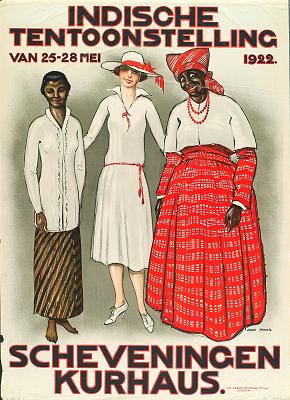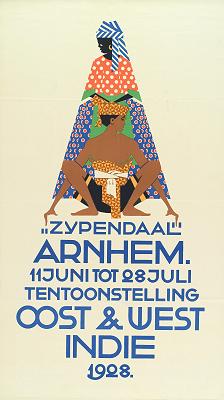
1922, Jack Pencil, Indische tentoonstelling 25 tot 28 mei 1922, Scheveningen Kurhaus

c. 1924, Joseph Rovers (1893 - 1976), Rotterdamsche Lloyd - Egypte, Ceylon, Sumatra, Singapore, Java

1928, Nicolaas P. de Koo (1881 - 1960), East and West Indian Exhibition in Arnhem
During the summer of 2005 the poster exhibition 'Cara Belanda' (the Dutch way) is organized on occasion of the 'Dutch East Indies Summer' project in The Hague, The Netherlands. Many of the cultural institutions in The Hague, museums, theaters, filmtheaters etc. participate in this citywide project.
Up to 1948 the country that is now called 'Indonesia' was a colony of The Netherlands and referred to as 'Indie' or 'the Dutch East Indies' as opposed to 'the Dutch West Indies' by which name Surinam and the islands Aruba, Bonaire, Curacao, Saba, Sint Eustacius and St Maarten off the east coast of South America were meant.
From July 14 onward De Affiche Galerij gives an interesting view of the relationship between the Netherlands and the East-Indies in the first half of the twentieth century.
In colorful images that used to enliven the streets, back in those days, cold and rainy Holland was seduced with tropical images and posters for exhibitions wherein the differences between the motherland and her colonies were explained. Though part of the kingdom, most dutch people never went to the Indies because they were so far, far away, inexplicably different and exotic and most people didn't know a lot about customs and native inhabitants.
In the colony, the East-Indies, posters were mostly made for the eyes of the 'belanda' the dutch people that lived overseas. A lot of the posters appeal to their longing for home and the posters helped bridge the distance by, for instance, anouncing the possibility to make a telephonecall. This of course was incredibly expensive, so ordinary people wrote letters and, on special occassions such as deaths and births, used the wireless cable. Imagine in the 19th century it took 9 weeks for a letter to travel by boat from the Dutch East-Indies to The Netherlands, no wonder the KLM advertised her weekly postal flights in the 1920's!
Still, traffic by sea and by air between The Netherlands and the East-Indies, was very busy which can also be seen in the cultural exchanges, all the advertisements for industrial exhibitions, theaterplays and books that were on view and published over the years. Posters for a number of this kind of events are on display.
In May of 1945 The Netherlands were liberated from German occupation by the allied forces. The East-Indies were still being occupied by the Japanese. Immediately after the liberation by the allied forces, in May of 1945 posters appeared in the straats of The Netherlands that call on the Dutch men to join the army, navy or airforce in order to liberate the colony from the Japanese invaders. A few examples of these propaganda posters can be seen in the exhibition.
Ten very special posters are on loan from the 'Museon' museum, here in The Hague. During World War II, dutch people that lived in the Dutch East Indies were imprisoned in Japanese prisoner camps. Trying to survive and make life as 'normal' as possible, a number of men formed a theater company that performed regularly. A number of posters for these performances (all in coloured pencil) has been saved and ten of them are shown in the exhibition 'Cara Belanda'.
The exhibitions in De Affiche Galerij (the poster gallery) are being organised by the The Hague Municipal Archives, www.gemeentearchief.denhaag.nl.
'Cara Belanda' (the Dutch way) - De Affiche Galerij (the Poster Gallery), Spui station, Tramtunnel in The Hague, The Netherlands from July 14 - September 23, 2005